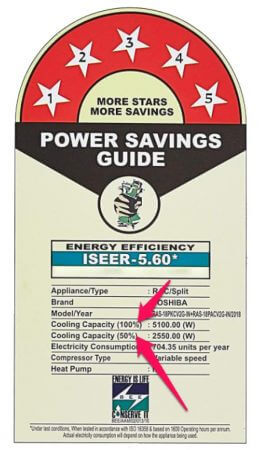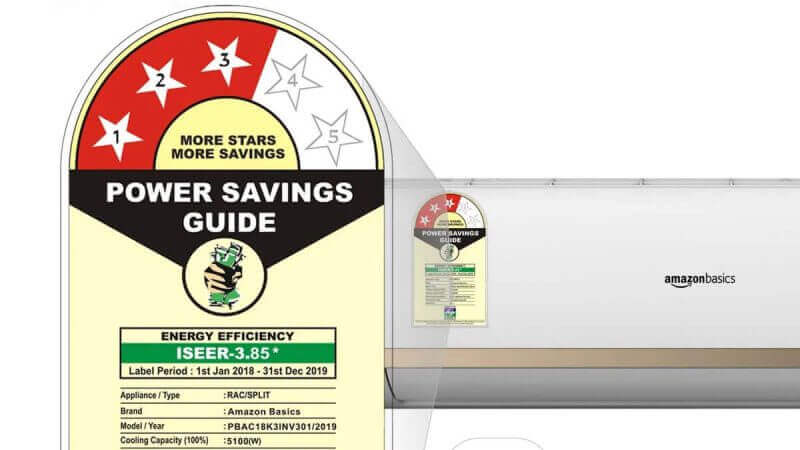When we go to the market to buy an AC, what is the first thing we consider?
The BEE star rating. Right?
If the star rating is high, the AC will consume less electricity. If not, it will consume more electricity. That is a general perception and it is true.
The Government Of India has made it mandatory for all Home Appliances manufacturers to show the BEE star rating on their products to let consumers know how much electricity that particular product is going to consume.
So basically, a star rating says how efficient your appliance is in terms of power consumption.
But do you know that there are so many other terms printed on the same star rating label? For example, EER, ISEER, COP, etc.? Understanding those terms is equally important to make a proper purchase decision.
For a general consumer, knowing about all those technical terms may not be that important. But when you are spending your hard-earned money on Appliances, it is not a bad idea to know few technical terms.
So in this article, we will talk about BEE star rating, EER, ISEER, COP, and the key differences between all those terms. But before that, we should know what is meant by efficiency.
What Is Efficiency?
The efficiency of a product is the ratio of output to input. For a given input, if the output is more, the efficiency will be more. On the other hand, if the output is less than the given input, that means the efficiency is less.
What Is BTU ( British Thermal Unit)?
BTU ( British thermal unit)is an international standard of energy used to measure the amount of heat required to raise one pound of water temperature by one degree Fahrenheit.
In AC and refrigerators, BTU means the amount of heat that it can remove per hour. If the BTU value is more, it can remove more heat and vice versa.
For example, if you have a 15×10 feet room, you may need an AC with 5400 BTU, if you have a 10×20 feet room, then you may need a 6000 BTU AC. So if your room sizes increase, you need an AC with a higher BTU.
What Is the Tonnage Of AC?
The cooling capacity of AC is measured in Tons. For example, An 1 ton AC can give you the same amount of cooling per hour that one ton of ice can give if you keep that much ice in a room. 1 ton AC is capable of removing 12000 BTU heat from a room.
Here is a simple chart showing the room size and an approximate tonnage value of an AC.
| Room Size (SFT-Square Feet) | Recommended AC Size |
|---|---|
| Up to 80 SFT | 0.75 Ton |
| 80-120 SFT | 1 Ton |
| 120-180 SFT | 1.5 Ton |
| 180-300 SFT | 2 Ton |
EER (Energy Efficiency Ratio)
EER stands for Energy Efficiency Ratio, which is equal to the amount of heat removed per hour divided by the electricity consumption by the air conditioner.
In other words, EER is the ratio of cooling competence in BTU per hour to the power input in watts.
Let me explain with an example.
If one 10,000 BTU air conditioner uses 1000 watts of power, then the EER rating would be 10, calculated by dividing 10,000 by 1000 (10,000/1000=10).
If the same AC ( 10000 BTU) consumes 1200 watts of power per hour, then the EER would be 10000/1200)= 8.33. So now you have understood that higher EER means more energy efficiency like BEE Star ratings.
Manufacturers no longer show EER values on their ACs. Instead, they show the ISEER value. We will learn the reason for that later in this article. Ideally, EER is now just a theoretical term.

SEER ( Seasonal Energy Efficiency Ratio)
SEER or Seasonal Energy Efficiency Ratio is similar to EER, but it considers seasonal variation as a factor. The reason is that in India, the season is not the same all across the country.
For example, in Delhi, for a room of 10X15 size, you may need 1 ton AC. But if you want to cool the same room in Himachal, you may need just a 0.5-ton AC. So seasonal variation is significant.
That is why, SEER adds a seasonal factor into the EER to calculate the SEER value. That factor value can be 0.5, 0.75,1,2, or anything depending on the season of that location.
SEER values are no longer shown on AC labels too as it is replaced by ISEER rating.
ISEER ( Indian Seasonal Energy Efficiency Ratio)
ISEER is the Ratio of the total annual amount of heat that an AC or Refrigerator can remove from the indoor air when operated for cooling in active mode to the total annual amount of energy consumed by the equipment during the same period.
The concepts of EER, SEER, and ISEER are the same. But ISEER considers two factors as shown below.
- CSEC (Cooling Seasonal Energy Consumption)
- CSTL ( Cooling Seasonal Total Load)
ISEER = CSTL/CSEC
CSEC (Cooling Seasonal Energy Consumption)
CESC is the total amount of energy consumption by the AC or Refrigerator per year when it is active, regardless of the cooling procedure.
CSTL ( Cooling Seasonal Total Load)
CSTL is the total amount of heat load that is removed by an AC or refrigerator per year when it is active, regardless of the cooling procedure.
The ISEER value printed on your AC box assumes that you will run the AC for 1600 hours per year. If you use the AC for more hours, then the efficiency may vary.
CoP (Coefficient Of Performance)
The coP is the ratio of the amount of cooling provided by an AC to the energy it consumes. So if the CoP is 1, then the AC will be 100% efficient.
We know that 1 KWH= 3412 BTU
1W= 3.412 BTU/Hr
Now let’s go to the formula of EER
EER= (BTU/hr)/ W= (BTU/Hr)/( 3.412 BTU/hr)= 3.412 CoP
EER= 3.412 CoP
BEE Star Rating
Whatever we discussed till now does not make any sense for general consumers to be very frank. What matters is the star rating.
If the BEE star rating is high, the machine is more energy-efficient. In India, the star rating and ISEER value are interconnected. What that means is that if the ISEER value is higher, the star rating value will also be high.

Here is the relation between ISEER and star rating in the Indian market.
| Star Rating | Minimum ISEER | Maximum ISEER |
|---|---|---|
| 1 | 3.33 | 3.49 |
| 2 | 3.50 | 3.79 |
| 3 | 3.80 | 3.39 |
| 4 | 4.40 | 4.99 |
| 5 | 5.00 |
Conclusion: BEE Star Rating
Now you all might have an idea about the different technical terms of AC. So next time when you buy an AC or Refrigerator, make sure you see the value of all those efficiency terms and then only take a decision. In that way, you will be saved from buying the wrong product.
If you still have any questions or queries, please write in the comment section, and I will be happy to assist.
FAQ | BEE Star Rating
What Is BEE Star Rating?
The BEE star rating represents the energy efficiency of the appliance. The BEE label features stars to show a product’s efficiency.